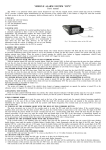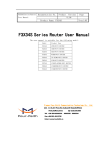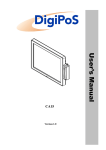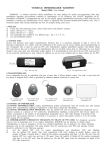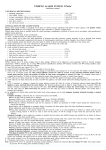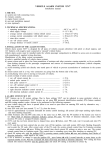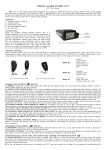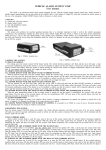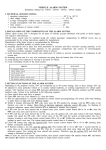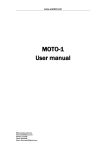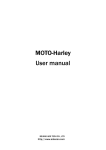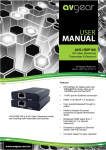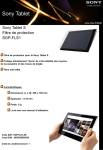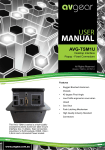Download "KODINIS IMB5" installation manual
Transcript
"KODINIS" IMB5, IMB5.1 Vehicle immobilizer Installation manual LED hole THE IMMOBILIZER PURPOSE Button Fig. 1. System unit. Fig. 2. ID card. The purpose of the immobilizer 'KODINIS' is the identification of the driver. The driver is identified, when the person with ID card comes inside the communication area. If the person has no ID card, the immobilizer regards the vehicle is under unauthorized use and transfers the signal for engine immobilization. SAFETY WARNINGS The immobilizer includes the system unit that must be installed inside the passenger compartment of the vehicle, and ID card (2.4GHz RF key), that has the driver. The ID card and the system unit provide RF communication. There are two ID cards in the set. It is possible to program up to 5 ID cards. The vehicle immobilizer manufacturer recommends the following: 1. Mount the immobilizer in place free from moisture and other elements that could pose to corrode the device. It should also be placed as far away as possible from any heat emitting elements in the passenger compartment and sources of electromagnetic interference (e.g., a vehicle computer, fans, relay blocks). 2. Avoid mounting the immobilizer directly onto metal parts of the vehicle to prevent the accumulation of condensation inside. 3. Mount the immobilizer so that the wire connectors are going from the bottom side of the immobilizer. 4. Avoid placing wires next to moving or hot parts of a vehicle. 5. Don't overload the immobilizer’s 1st optional control (Oc1) circuit 4 : the current should not exceed 0.3 A. 6. For EU countries only use settings compatible with EU Directives. SPECIFICATIONS 1. 2. 3. 4. 5. 6. Operating temperature range .......................................................................... Supply voltage ................................................................................................ Average consumption current (except OC1) ................................................ Average control distance ................................................................................ Communication frequency range ................................................................... Pulse radiated power ...................................................................................... - 40°C / +85°C. 9 - 15 V (nuolatinë átampa). no more 10 mA (U = 12 V). 1 – 2 m. 2,4 GHz. No more 1mW. INSTALLATION SEQUENCE 1. 2. 3. 4. 5. Select the purpose of the OC1 – Optional Control One (FN51). Select the purpose of the input DOORS(-) (FN64). Install the immobilizer in accordance with the wiring diagram, paying attention to the selected OC1 and DOORS(-) purpose. Customize immobilizer if default settings are not suitable. Fill out an installation certificate. WIRING DIAGRAM Immobilization circuit with normally open (NO) relay contacts (FN51, NN=4) +12 V Switches in the door strut, input DOORS(-) (FN64, NN=1) OC1 87 85 30 86 3A - 87a +12 V 30 86 3A Immobilization circuit with normally closed (NC) relay contacts (FN51, NN=1) 1-second pulse for external engine immobilization device (FN51, NN=2) OC1 Automatic engine start module (FN64, NN=4) Immobilizer status (Fn51, NN=3) OC1 Connection with alarm system (FN51, NN=5) OC1 Communication with ID card status indication (FN51, NN=6) OC1 87 85 Authorization button (FN64, NN=2) +12V Ingition switch ON ACC START System LED +12 V Battery +12V 5A + - „Ground” (Car’s body) Buzzer Black Yellow Blue Grey Brown White Red Red Black 1 2 3 4 5 6 7 1 2 OC1 87a IMB5 "KODINIS" IMB5, IMB5.1 Vehicle immobilizer Installation manual SYSTEM SETUP MODE The 'IMB5' features up to 24 system settings. Due to these settings the 'IMB5' can be adjusted to a particular vehicle or relevant customer’s requirements. The immobilizer is supplied with the factory preset default settings listed in the table. If the default settings are not suitable for the user you can customize them. To customize the immobilizer do the following steps: 1. Enter the PIN code (see TURNING ON THE OVERRIDE MODE in User manual). 2. If it is necessary to program no ID card, wait for 3 seconds with ignition is turned OFF, untill the system LED will finish tripple flashes and will start frequent flashes. You have 80 seconds (control time) to start entering the FN. Sample 1 – the sequence of the FN21 setting checking up: Double flashes ON OFF ON Orange Double flashes OFF 8 min. 8 min. FN digit '2' is entered FN dgit '1' is entered Press the button on Number of short buzzer Short buzzer sound shows, that right FN is the ID card, which sounds shows current SN entered, the control time is is turned OFF value, the control time extended up to 8 minutes is extended up to 8 minutes Sample 2 – the sequence of the FN22 setting SN=2 entering, checking up and returning to operating mode: Double flashes ON OFF ON Double flashes Orange ON OFF OFF 2-3 seconds 8 min. FN digit '2' is entered 8 min. Short buzzer sound shows, that right FN is entered, the control time is extended up to 8 minutes FN digit '2' is entered Orange ON Double flashes O FF ON Press twice (SN=2) the button on the ID card, which is turned OFF Double flashes Long buzzer sound shows, that right SN value is entered successfully, the control time is extended up to 8 minutes Green OFF 8 min. Press the button Number of short buzzer on the ID card, sounds shows the new entered which is SN value, the control time turned OFF is extended up to 8 minutes FN digit '1' is entered FN digit '1' is entered Rare system LED flashes shows ID card is turned ON, immobilization that the system is in normal signal is turned OFF, operating mode, the engine system LED goes OFF immobilization signal is ON LEARNING THE ID CARDS The user can learn to the system up to 5 ID cards. The all early learned ID cards are deleted from the system. It is highly useful, if ID the card is theft or lost. The ID cards must be turned OFF during learning. Action sequence: 1. Enter the PIN code (see TURNING ON THE OVERRIDE MODE in User manual). The system LED will flash for 2 seconds by triple flashes. It is necessary to turn ON the ignition during this time. Triple flashes 2 seconds ON 12 sec. The control time is extended up to 12 seconds Orange OFF 1 sec. Trigubi 12 sec. blyksniai Orange 1 sec. 12 sec. The button on The button on 1 second flash, the 1 second flash, the the 1st ID card is pressed button is released, the the 2nd ID card is pressed button is released, the and hold pressed down 2nd ID card is learned and hold pressed down 1st ID card is learned Triple flashes 12 seconds AVAILABLE IMMOBILIZER SETTINGS In the column named "EU" the settings which comply with the requirements of EU Directives are indicated with a tick mark . Selection of settings not complying with the EU requirements is allowed if the vehicle is operated outside the EU states. In the column "IMB5" the settings which present with the immobilizer software version are indicated by a tick mark . The factory default (pre-set) settings are indicated with the tick mark in the "IMB5" column. FN=11 Function: EXIT OVERRIDE MODE. FN=21 Function: IMMOBILIZATION SIGNAL. The immobilization signal is turned ON when the 20 second time after the ignition is turned OFF is elapsed, if there is no programmed ID card signal in the SN=1 communication area. The signal is turned OFF when appears programmed ID card signal and authorization button is pressed (depending on FN64 setting). SN=2 Immobilization signal is turned OFF. FN=22 Function: 'ANTI-CARJACK'. SN=1 'Anti-carjack' is turned OFF. 'Anti-carjack' procedure is triggered by ignition turning ON with no programmed ID card inside communication area or by ID card signal loss with ingnition is turned ON. The immobilizer waits for programmed ID card signal within 120 second override time and follows 'anti-carjack' operation settings (FN23). With the SN=2 last 25 seconds the immobilizer warns by short buzzer signals with increasing frequency. In 10 seconds warning signal becomes continuous. 'Anti-carjack' operation cancelling or trigger prevention is available at any time by programmed ID card signal inside communication area. If is selected (SN=2 for FN64) and immobilization signal is turned OFF (SN=2 for FN21), the authorization button should be pressed every time when the ignition is turned ON. IMB5 FUNCTION EU AVAILABLE SETTINGS "KODINIS" IMB5, IMB5.1 FUNCTION SN=3 'Anti-carjack' procedure is triggered by ignition turning ON with no programmed ID card iside communication area. The immobilizer waits for programmed ID card signal within 60 second override time and follows 'anti-carjack' operation settings (FN23). With the last 25 seconds the immobilizer warns by short buzzer signals with increasing frequency. In 10 seconds warning signal becomes continuous. 'Anti-carjack' operation cancelling or trigger prevention is available at any time by programmed ID card signal inside communication area. If is selected (SN=2 for FN64) and immobilization signal is turned OFF (SN=2 for FN21), the authorization button should be pressed every time when the ignition is turned ON. SN=4 'Anti-carjack' procedure is triggered by ignition turning ON with no programmed ID card inside communication area or by opening the door with ignition is turned ON and the ID card signal loss afterwards. The immobilizer waits for programmed ID card signal within 60 second override time and follows 'anti-carjack' operation settings (FN23). With the last 25 seconds the immobilizer warns by short buzzer signals with increasing frequency. In 10 seconds warning signal becomes continuous. 'Anti-carjack' operation cancelling or trigger prevention is available at any time by programmed ID card signal inside communication area. If is selected (SN=2 for FN64) and immobilization signal is turned OFF (SN=2 for FN21), the authorization button should be pressed every time when the ignition is turned ON. FN=23 Function: IMMOBILIZATION SIGNAL DURING 'ANTI-CARJACK' OPERATION. With the last 15 override time seconds the buzzer signal becomes continuous, after 15 seconds the buzzer signal is turned OFF and immobilization signal is turned SN=1 ON. The immobilization signal can be transfered to OC1 (SN=1, SN=4 for FN51), to alarm system (SN=5 for FN51) or to external immobilization equipment (SN=2, SN=6 for FN51). For immobilization signal cancelling is necessary the turned ON programmed ID card inside communication area and the authorization button press (depending on FN61, FN64 settings). With the last 15 override time seconds the buzzer signal becomes continuous, you can turn OFF it only by turning OFF the ignition, but not earlier as the override time elapses. The immobilization signal is turned ON only as the ignition is turned OFF, it can be transferred to OC1 (SN=1, SN=4 for FN51), to alarm system (SN=5 for FN51) or external immobilization equipment (SN=2, SNF=6 for N51). For immobilization signal cancelling is necessary the turned ON programmed ID card inside communication area and the authorization button press (depending on FN61, FN64 settings). With the last 15 override time seconds the buzzer signal becomes continuous and the immobilizer starts to transfer „a soft” (gradual) immobilization signal to OC1 (SN=1, SN=4 for FN51). When the override time elapses the buzzer signal is turned OFF and the immobilization signal is turned ON. The immobilization SN=3 can be transferred to Oc1 (SN=1, SN=4 for FN51), to alarm system (SN=5 for FN51) or to external immobilization equipment (SN=2, SN=6 for Fn51). For immobilization signal cancelling is necessary the turned ON programmed ID card inside communication area and the authorization button press (depending on Fn61, FN64 settings). FN=43 Function: ID CARD SIGNAL LOST WARNING. SN=1 Warning is ON. When 20 second time elapses after the ID card signal is lost the immobilizer warns every 5 seconds within 3 minute time by buzzer sounds. SN=2 Warning is OFF. FN=45 Function: LOW ID CARD BATTERY WARNING. SN=2 SN=1 SN=2 FN=51 SN=1 Warning is ON. When the ignition is turned ON the immobilizer warns by the series of 4 double buzzer signasl with interval of 1.7 second. Warning is OFF. Function: IMMOBILIZATION SIGAL. SN=2 When the ignition is turned ON with immobilization signal ON, the negative polarity 1 second duration pulse, intended for an external immobilization equipment, is transferred to OC1. The immobilization signal is transferred to optional control 1. The OC1 is used for control a relay with normally closed contacts. If the immobilization signal is ON, the negative polarity signal is transferred to OC1. If the immobilization signal is OFF on OC1 presents no signal. The immobilization signal is transferred to optional control 1. The OC1 is used for control a relay with normally closed contacts. Communication with an alarm system. Oc1 is intended wit alarm system listed in compatible system list. The constant negative polarity signal is tranfered to OC1, if communication with ID card is OK. If the communication, fails the signal transfer is terminated with 5 second delay. SN=7 The constant negative polarity signal is tranfered to OC1, if communication with ID card is OK. If the communication fails, the signal transfer is terminated with 0.7 second delay. FN=61 Function: AUTHORIZTION BUTTON PRESS. SN=1 Single press. The authorization button must be pressed 1 time within 5 sesecond time till ignition turning ON or arter ignition turning ON. SN=2 Double press. The authorization buttton must be pressed 2 times within 5 sesecond time till ignition turning ON or arter ignition turning ON. FN=64 Function: INPUT 'DOORS (–)' PURPOSE. SN=1 Dooors (–). SN=2 Authorization button (–). SN=3 Not used. AUTOSTART (–). When the input is connected to a low-level signal source (no more than +0.5 V) the immobilization signal is turned OFF. An automatic engine SN=4 start module can to turn ON the ignition and starter. While the input is connected, PIN code entering is unavailable. FN=81 Function: CHANGING THE PIN. FN=91 Function: RESTORE FACTORY DEFAULT SETTINGS. SN=1 Restore default factory settings and the default PIN code. SN=3 SN=4 SN=5 SN=6 CERTIFICATE OF INSTALLATION. I, undersigned qualified installer certify that installation of (Name, Surname) the below described vehicle alarm system has been carried out by myself pursuant to installation manual supplied by the manufacturer of the system. Vehicle description: Manufacturer and model: Serial number: Registration number: Description of vehicle immobilizer: Type: 'IMB5'. Model: Official approval number: Installation date: Installing company: SEAL Installer: (Position, signature) After installation of the alarm system installer must fill in CERTIFICATE OF INSTALLATION! It is recommended to mark selected settings in the TABLE OF ALARM SYSTEM SETTINGS (underline SN). IMB5 Installation manual EU Vehicle immobilizer




